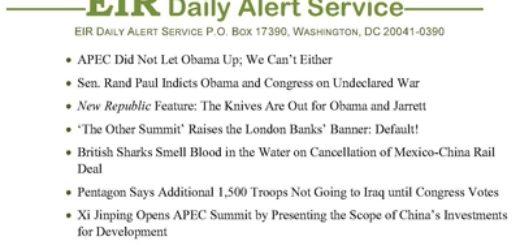EIR Daily Alert Service, TUESDAY, April 2, 2019
NASA’s Bridenstine Affirms Moon-Mars Program Is ‘Once in a Lifetime Opportunity’
Trump Planning Next Steps in North Korea Dialogue
Yang Jiechi Updates Belt and Road Achievement, with 40 State Leaders To Attend Forum
Japan’s Fukuda Praises Belt and Road as ‘About More Than Just One Country’s Interests’
Martens Argues Congress Must Pass Glass-Steagall, as Big Five Are Signaling Blowout
Documentation: China Banks Are Under Glass-Steagall Regulation
| Subscribe to EIR Daily Alert |
EDITORIAL
Today’s Moon-Mars Mission as LaRouche Would Have Done It
April 1 (EIRNS)—President Donald Trump has followed up the big defeat for the “Russiagate” coup against him, by immediately setting out the boldest and most nationally inspiring goals for NASA and space exploration—just as Lyndon LaRouche advised any and every President to do during his lifetime.
The goals set out by the enthusiastic NASA Administrator Jim Bridenstine this afternoon were extremely ambitious. “This is a big charge, and it comes straight from the top,” he told NASA scientists and engineers and all other Americans watching. “This is the opportunity of a lifetime. This is a mission that you’re going to tell your grandchildren where you were when this was announced…. We’re going to the Moon in five years. This has not been done before.” And, he stated, “there are holes here”—technology breakthroughs needed in a hurry.
In fact, these goals can only be met with the support of a mobilized American people, and through cooperation with other space-faring powers China, Russia, and India. Even after decades starving NASA of funds and missions, Americans of all generations still know that the frontiers of scientific knowledge, and of human achievement, are in space.
Lyndon LaRouche expressed this exactly in a published article in June 1985, “International Private Initiative on Behalf of the Successive Colonization of the Moon and Mars,” which EIR is republishing this week to get this scientific and cultural “remobilization” going. LaRouche wrote:
“Therefore, the best way to achieve breakthroughs in each and all of the kinds of applications of technological progress over the coming fifty years or so, is to create a mission-oriented, crash-program task-force, assigned to developing all of the technologies required for beginning the permanent colonization of Mars by some preassigned target-date, such as 2010 A.D….
“There is no advancement in the general level of technology which is not subsumed by the Moon-Mars mission-assignment? Very well, for a period of perhaps the next twenty years, let us write ‘Moon-Mars-colonization mission-assignment’ wherever present custom would have us write the words ‘science’ or ‘technological progress.’ Every important breakthrough accomplished during that period, or longer, will be either implicitly required for accomplishment of the mission-assignment, or will occur as a by-product of that mission-assignment. Once all the technology needed for a permanent colonization of Mars is completed, perhaps twenty years ahead, we shall then shift the mission-assignment, to a next, more ambitious task….”
President Trump is opening up this mission at a point when China’s Belt and Road Initiative of “great projects” has begun to be welcomed in Western (Italy, Luxembourg, Spain, Portugal) as well as Eastern Europe, and has started development projects in Africa. The neo-cons infesting the White House may think they can block this with Cold War. But the progress of this project, first conceived of as Lyndon and Helga LaRouche’s World Land-Bridge, is continuing—and is vital to the future of humankind.
Bolton and the others may also think they can defy the President’s intentions to end regional regime-change wars and pursue great-power cooperation. His order for the accelerated Moon-Mars mission has the potential to mobilize the American population to insist on peace through scientific cooperation. That is how Lyndon LaRouche would have conceived it.
SCIENCE AND INFRASTRUCTURE
NASA’s Bridenstine Affirms Moon-Mars Program Is ‘Once in a Lifetime Opportunity’
April 1 (EIRNS)—In an agency-wide NASA Town Hall this afternoon to discuss the U.S. plans for going to Moon and then to Mars, Administrator Jim Bridenstine made a very short opening statement, saying there are a lot of questions, discussion, and excitement. The program is doable he said, “given the resources and tools.” Then he went right “to open the discussion, the dialogue, about how we’re going to achieve it.”
The agency town hall was broadcast on NASA TV, and also streamed on its website.
Most impressive was 1) Bridenstine’s understanding of the hesitation, if not pessimism, on the part of the workforce who had worked on two previous, cancelled Moon-Mars missions. He will overcome that to the extent he can assure NASA people that this administration will follow through. And 2) his ability to respond to technical questions and answers, which is not inconsequential for a science and technology agency, or to the people who have to solve such questions.
Bridenstine’s major points:
On whether the program will be backed up with funding, the Administrator addressed what is on people’s minds, as he has been reminded of “hundreds of times” about the fact that programs to go to the Moon got cancelled “because the resources didn’t materialize.” (Both George H.W. Bush and George W. Bush had Moon-Mars programs, which NASA people attending the live town hall had worked on, that got cancelled.) Bridenstine assured the workforce that “the administration is committed” to carry it through. Asked again about commitment, and programmatic “whiplash,” Bridenstine, a former congressman, pointed out the consistency of support on the part of Congress, and the “level of certainty while Trump is still there.”
He affirmed later that he “believes we’re going to meet the deadline” of 2024; it is so “important to the administration” that the deadline is in “Trump’s second term,” meaning he will be held accountable if it fails.
Asked about “schedule over safety,” on the minds of NASA staffers who went through two Space Shuttle accidents, Bridenstine said “the number-one mission is schedule with safety.” We won’t go in 2024 “if it’s not safe,” he said.
To conclude, Bridenstine said this is a “big charge,” which we should “embrace, and give it full force.”
U.S. POLITICAL AND ECONOMIC
Who Is Stoking the Fires of a Massive Refugee Crisis on the U.S.-Mexico Border?
April 1 (EIRNS)—The number of Central American refugees traveling through Mexico to seek asylum in the United States has risen dramatically over the last six months, with over 100,000 expected to cross over in April, according to U.S. officials, the largest monthly number in a decade. It’s reported that most of the migrants are Central Americans, and not Mexicans, and that the vast majority simply turn themselves in to authorities once they are on U.S. territory, in hopes of achieving asylum. U.S. Customs and Border Patrol officials are saying that the situation has hit its breaking point, and that they are swamped and unable to deal with the human tidal wave. President Donald Trump has announced a cut in U.S. aid to Honduras, Guatemala and El Salvador for failing to stem the flow, and is threatening to shut down the U.S.-Mexico border entirely.
According to numerous Mexican press accounts, Presidential adviser Jared Kushner traveled to Mexico and met privately on March 16 with President Andrés Manuel López Obrador (AMLO) and his Foreign Minister Marcelo Ebrard, to demand action from Mexico. AMLO removed the migrant matter from the Government Ministry’s portfolio, where it has historically been, and placed it instead under the Foreign Ministry, but otherwise seems as overwhelmed as the United States is by the escalating crisis. The Mexican daily El Universalreports that there are thought to be 100,000 Central American migrants inside Mexico, but the government has totally lost control of how many and where they are.
The underlying economic and social implosion in Central America and Mexico—real unemployment ranging from 50-80%; the world’s highest homicide rates due to drug trafficking and related gang warfare; near lawlessness and control by organized crime in much of the area—is the dry tinder for the crisis. But everything indicates that someone has also lit the match, intentionally triggering an out-of-control border crisis, of the sort that would have delighted the infamous William Paddock (“shut the border and let them scream”). It all points to London’s Dope, Inc. drug-running apparatus.
Mexico’s Government Minister Olga Sanchez Cordero stated in an interview with El Sol de México that huge caravans from Honduras and elsewhere in Central America are being instigated by organized-crime networks, including those involved in human and organ trafficking. She said that a mother of all caravans of 20,000 people is now being organized in Honduras. Honduras’ Deputy Foreign Minister Nelly Jerez Caballero responded that her country’s intelligence agencies have no such information, and demanded that Sanchez explain the source of her intelligence.
Only four months after AMLO’s assuming the Mexican Presidency, London has largely managed to shift the agenda from U.S.-Mexico cooperation on economic development to address the migrant crisis, which was the stated policy of both Trump and AMLO, to an out-of-control crisis and confrontation between the two countries. The British-neocon gambit of drawing the Trump Administration into a regime-change operation against Venezuela, which is part and parcel of the drive to overthrow the Trump Presidency as well, has played a key role in that shift in the agenda region-wide.
Just think of what the region would look like if the United States and China had already jointly broken ground on building a high-speed railroad from Panama, through Central America and into Mexico and the United States, as the backbone of an industrial development corridor that would provide millions of productive jobs to the region’s desperate population. That’s the last thing that Dope, Inc. wants to have happen.
Trump Planning Next Steps in North Korea Dialogue
April 1 (EIRNS)—South Korean Foreign Minister Kang Kyung-wha was in Washington last week, meeting with Mike Pompeo on March 29, Hankyoreh reports, while Kim Hyun-chong, second deputy chief of South Korea’s National Security Office, arrived in the U.S. on March 30 and plans to meet with Deputy National Security Advisor Charles Kupperman today. These meetings are preparing for the South Korea-U.S. summit between Presidents Donald Trump and Moon Jae-in coming up on April 11 in Washington.
According to Hankyoreh, a pro-government Seoul newspaper: “Seoul is aiming for an overarching framework consisting of a comprehensive agreement and step-by-step implementation. Under this vision, North Korea and the U.S. would first agree on how they define denuclearization, what the final stage will look like and how they will get there, and then move toward that goal in stages along with corresponding measures from the U.S.”
The idea is that the U.S. and North Korea would agree on a final overall agreement before discussion of the steps to get there. What Trump rejected at the Hanoi Summit was a partial agreement, with some sanctions lifted for some nuclear facilities taken down, but without an overall agreement on the final outcome.
Both North and South Korea are anxious to resume the Kaesong Complex operations and the Mt. Kumgang tourism arrangements.Hankyoreh reports: “On March 29, a high-ranking official in the South Korean government told reporters that the U.S. fully understands the necessity of continuing to implement inter-Korean agreements as well as South Korea’s determination to do so. This official added that the issues of the Kaesong Complex and tourism to Mt. Kumgang had been comprehensively discussed during Kang and Pompeo’s meeting but that they didn’t get into the specifics.”
Also under discussion is a “snapback clause,” with partial sanction relief but an understanding that they would be restored if progress is delayed. Hankyoreh wrote: “North Korean Vice Foreign Minister Choe Son-hui recently referred to the snapback, saying that Trump had been open to the idea during the Hanoi summit…. Seoul is also stressing the need for Kim [Jong Un] and Trump to maintain their top-down approach as they have thus far in the North Korea-U.S. dialogue”—i.e., to keep Trump directly running the dialogue, to “minimize the threat posed by the growing influence of hardliners inside the U.S. administration.” The article referred to Trump’s reversal of the new sanctions announced by the Treasury Department and backed by National Security Advisor John Bolton last week.
THE NEW GLOBAL ECONOMIC ORDER
Yang Jiechi Updates Belt and Road Achievement, with 40 State Leaders To Attend Forum
April 1 (EIRNS)—State Councillor Yang Jiechi in a March 29 interview to People’s Daily outlined the overall benefits of the Belt and Road Initiative after six years. He stated in particular that it has been built on the idea of a new type of relationship between nations, a relationship based on mutual respect, consultation, inclusiveness and mutual benefit rather than confrontation. The BRI is also aligned with the various development plans of the participating countries and with the overall direction of the UN 2030 Agenda for Sustainable Development. It has boosted global connectivity and delivered fruitful outcomes in improving people’s lives in the participating nations.
Yang said that this year, Belt and Road Forum for International Cooperation will gather representatives from over 100 countries, including 40 heads of state and leaders of government who have confirmed attendance. The May 14-15, 2017 Forum was attended by 29 heads of state and government. The Forum will include the opening ceremony, a leaders’ roundtable, a high-level meeting, thematic forums, a CEO conference and other side events. The second Forum is expected to produce a full range of outcomes, Yang said, including government cooperation agreements and concrete cooperation projects involving participation of the business sector. It will also encourage trilateral cooperation and encourage cooperation among participating countries in third markets.
Yang pointed out that, as a result of the BRI, some countries now have their first motorways or modern railways, and many have seen an end to their continual power shortages. Through the BRI Kazakhstan now has access to the Pacific through Lianyungang. And thanks to the China-Europe Railway freight services, Chinese companies operating in Duisburg have increased from 40 in 2014 to more than 100 and the rail services have created more than 6,000 jobs there. The port of Piraeus in Greece went from 93rd place in global container traffic in 2010 to 36th place. The port employs about 10 Chinese staff, but 3,000 Greeks and has indirectly created more than 10,000 local jobs.
Chinese investment in Egypt has made it the world’s third largest producer of fiberglass. And the 82 cooperation parks built under the auspices of BRI in host countries have created about 300,000 jobs in those countries. The upcoming Belt and Road Forum will help to consolidate these gains, Yang said.
He also didn’t mince his words in addressing those who have been criticizing the BRI, calling these critics “prejudiced.” “This obviously shows a lack of objectivity and fair understanding of the Belt and Road Initiative. It is a misunderstanding, misjudgment and is even prejudiced,” Yang said. “To date no participating country has faced a debt crisis—to the contrary, many countries have been able to escape the ‘no development trap,’ ” he said.
Yang gave an interview the same day to multiple media on the Forum, with Xinhua publishing “Full Text: Yang Jiechi on the Belt and Road Initiative and Preparations for the Second Belt and Road Forum for International Cooperation” in English on March 30.
Global Times Applauds Luxembourg Joining Belt and Road as a ‘Big Deal’
April 1 (EIRNS)—China’s Global Times published a March 31 business column by Hu Weijia on Luxembourg’s joining the Belt and Road Initiative, entitled, “Why Luxembourg’s Endorsement of BRI Is Big Deal”; although it acknowledged that the China-Luxembourg agreement, signed on March 27 at Hainan was overshadowed by that signed by Italy’s Prime Minister Giuseppe Conte and President Xi Jinping during his state visit in Rome the week before.
“Luxembourg is far behind Italy in terms of economic size, but the small nation is a hub for financial institutions operating on a cross-border basis in the European market,” Hu wrote. “It is the Eurozone’s leading financial center and the world’s second-largest fund market” after London.
Luxembourg was also the first European nation to join the Asian Infrastructure Investment Bank, writes Hu. “Luxembourg can perhaps serve as a pragmatic bridgehead for cooperation between the BRI and Europe,” the column said. It indicated that China and Luxembourg could cooperate in “alleviating debt-related problems” for countries along the BRI.
Japan’s Fukuda Praises Belt and Road as ‘About More Than Just One Country’s Interests’
April 1 (EIRNS)—Former Japanese Prime Minister Yasuo Fukuda, speaking on March 28 at the annual Boao Forum for Asia on Hainan Island, said that China’s Belt and Road Initiative is “about more than just the country’s own interests, but is also an effort to build a community with a shared future for the whole of mankind.” “All the people of the world are on the same ship called Earth and it’s necessary to join hands to face global challenges and ensure the boat is stable and able to sail to far-off places,” he said.
Fukuda said China had made great strides in the past 70 years since its founding in 1949, but that the country should not be content with the status quo. He said China should continue its reform and development and create a better life for its people. “The stronger China becomes, the more it needs to consider how to do a good job in its overall management,” he said. “In short, China is shouldered with a growing global responsibility, and the Chinese people must think from a global perspective.”
COLLAPSING WESTERN FINANCIAL SYSTEM
Martens Argues Congress Must Pass Glass-Steagall, as Big Five Are Signaling Blowout
April 1 (EIRNS)—Banking expert Pam Martens used her April 1 “Wall Street on Parade” column to outline a financial blowout threat that is no joke: The five biggest U.S.-based banks notified the Securities and Exchange Commission (SEC) in their own annual reports for 2018, that their immense derivatives exposures “could blow up Wall Street again.” Martens detailed all five, but used JPMorgan Chase as her first example because of the massive losses its derivatives portfolio whacked it with back in 2012.
JPMorgan stated that it has sold credit default derivatives on $177 billion of “sub-investment grade,” or junk, loans and bonds. That puts it on the hook for huge payouts if this junk defaults. And it acknowledged to the SEC that although it has monitored this risk—and may have offset it by buying other huge piles of credit derivatives—“its efforts to diversify or hedge its exposures against those risks may not be successful,” she quotes the bank’s annual report.
Most important here is that the $177 billion in junk debt Morgan has insured is 55% more than it had done for such junk in 2012, when those junk credit derivatives suddenly lost the bank’s London division a whopping $6.2 billion. These were the so-called “London Whale” derivatives holdings. Essentially JPMorgan was claiming to be more careful now. Yet, as Martens explains, the bank has, in fact, just brazenly told the SEC that it has a much larger position in credit derivatives than it is allowed to have, even under current, emasculated bank regulations.
Bank of America, Citigroup, Goldman Sachs and Morgan Stanley provide only slight variations from this picture in their filings, each quoted in detail.
These SEC filings, Martens writes, “provide the strongest argument thus far for Congress to enact legislation to separate the Federally insured, deposit-taking commercial banks from the trading casinos on Wall Street. In other words, Congress needs to restore the Glass-Steagall Act, which kept the U.S. financial system safe for 66 years until its repeal in 1999.”
Usefully for this purpose, the column also gives the latest figures for the total face-amount holdings of financial derivatives contracts by these big five banks. They are: JPMorgan Chase, $48.2 trillion; Citigroup, $47 trillion; Goldman Sachs, $42.3 trillion; Morgan Stanley, $32 trillion; and Bank of America, $31.7 trillion; total exposure, $201 trillion.
Documentation: China Banks Are Under Glass-Steagall Regulation
April 1 (EIRNS)—In the early 1990s, some financial institutions in China treated the inter-bank lending market as an easy and low-cost place to raise funds. Some borrowed heavily to invest in real estate. They also speculated savings deposits into the stock market. By the summer of 1993, deposits in commercial banks were insufficient to cover development needs.
The result was that the State Council determined that the People’s Bank of China (PBOC) central bank was given independence in conducting the monetary policy of the nation. The PBOC issued in June 1993, “Some Opinions Regarding the Current Economic Situation.” It spelled out that the PBOC would “separate commercial banks from their affiliated trust and investment firms….” Further, a concise document consisting of six bullet points, the “Memorandum of the Chinese Communist Party Central Committee, 14 November 1993,” defined the PBOC’s new power, under the State Council, to “conduct monetary policy independently”; “supervise all other financial institutions”; and further: “The banking business and the securities business shall be separated.”
A number of Chinese specialists report that these measures were modeled on the U.S. Glass-Steagall law of the time, or otherwise state that the measures were equivalent to Glass-Steagall.
References: See “Transforming China’s Traditional Banking Systems under the New National Banking Laws” by Andrew Xuefeng Qian, in the Georgia Journal of International and Comparative Law, Vol. 25:478, pages 489-490; and also Banking Reforms and Monetary Policy in the People’s Republic of China by Yong Guo (2002).
See also, “The Intrinsic Logic of China’s Banking Industry Reform” by Yi Gang, in Transforming the Chinese Economy, Chapter 4, pages 141-143, edited by Fang Cai (2010). (From the China Vitae of the Carnegie Endowment for Peace: As of 2018, Yi Gang has been the Governor of the People’s Bank of China. He became secretary-general of the Monetary Policy Committee of the People’s Bank of China in 2002-2008, and Deputy Governor of the People’s Bank of China in 2008-2018. From 2009-2016 he was Director of the State Administration of Foreign Exchange (SAFE). In 2014 he was named Deputy Director, General Office of CPC Central Leading Group for Finance and Economics; and 2017, Alternate Member, 19th CPC Central Committee.)















